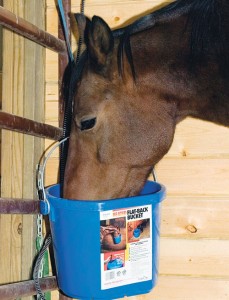It’s essential to keep your trail horse well-hydrated during winter. Maintaining his body fluids at optimum levels is his best defense against the cold — and colic. Adequate water in his system allows him to efficiently digest feed and convert food calories into body heat.

Your horse’s drive to drink is dictated by his thirst. The problem, of course, is that the colder it gets, the less he’ll feel like drinking — even when his body really needs fluid.
The most important thing to prevent dehydration in your horse is to make sure your horse’s water supply is a comfortable drinking temperature. Studies show that horses consume more water when it’s tepid — that is, in the mid-60-degree Fahrenheit range.
Here’s how to warm your horse’s water to encourage him to drink enough this winter.
Electric Buckets
Buckets with built-in electric heaters provide an economical way to raise the water temperature. Of course, you’ll have to be prepared to refill those buckets twice daily or more, since an average horse will drink approximately six to eight gallons each day.
A standard bucket holds approximately five gallons, although some do come in 16-gallon and larger sizes. If your horse is consistently draining his bucket dry between refills, you’ll need to add a second, or invest in a bigger one.
One advantage to using a heated bucket is you’ll have a fairly good idea how much your horse is actually drinking. And you’ll be supplying fresh water with every refill, which may encourage your horse to drink more than he might from a large tank that gets cleaned and refilled less frequently.
Troubleshooting tip: If your horse’s manure seems dry, or he’s passing piles less frequently, he’s likely not drinking enough. Impaction could be a concern. If you’re conscientiously supplying plenty of clean, tepid water, you may want to add a tablespoon of salt to his daily ration to help stimulate his thirst.
Tanks & Waterers
In herd situations, heated automatic waterers or stock tanks with heating units might be the most practical way to keep enough water at a drinkable temperature for the entire group.

Situate tanks and waterers in a sheltered area, out of the wind. Set them up so heater cords and electrical connections are out of harm’s way.
Sinking tank heaters, versus floating units, might be less tempting for playful horses to pull from the tanks. If you have a plastic or fiberglass stock tank, use a safety cage around the heating element to protect the tank from melting.
Check your tank heaters daily to make sure they’re working and that nothing has gone awry. Check your electrical breakers, too. If your tank heater has blown a fuse, it’s a warning sign that something is amiss. Remove and/or replace the unit before resetting the circuit. You don’t want to risk being shocked.
If you’re running hoses from hydrants to stalls, paddocks, or runs, disconnect and drain them after each use. That way, they’ll be ready to go the next time tanks and buckets need refilling. This precaution will also help prevent plumbing damage during a deep freeze.







